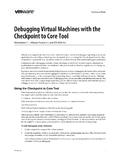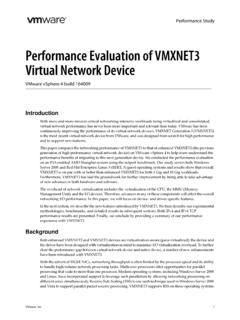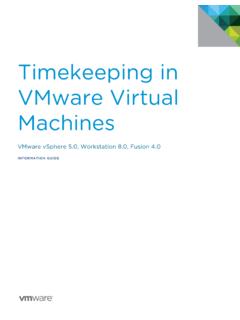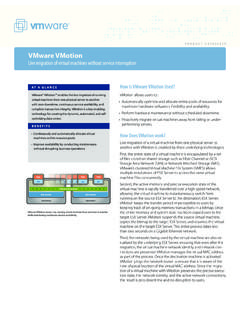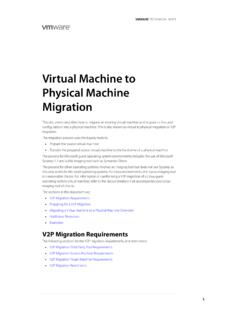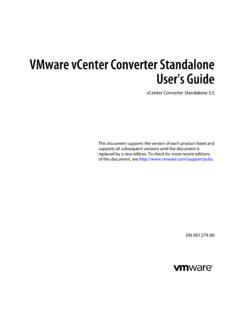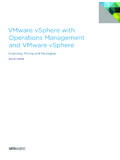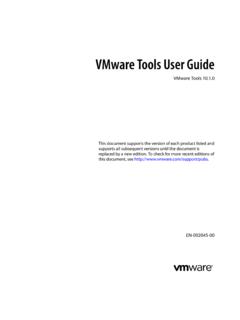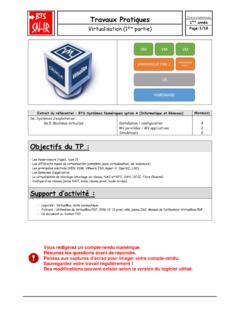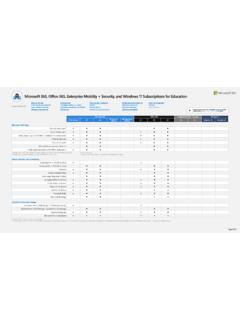Transcription of Microsoft SQL Server and VMware Virtual Infrastructure
1 Microsoft SQL Server and VMware Virtual Infrastructure BEST PRACTICESVM ware Microsoft SQL Server and VMware Virtual Infrastructure Contents Common Questions and Considerations ..1 Representative Customer Data ..2 Characterizing SQL Server for Virtualization ..3 Understanding Your Business and Technical Understanding Availability Requirements ..4 Understanding Other Deployment, Management, and Monitoring Capturing resource Utilization Baseline for Existing Databases ..6 Migrating to Virtual VMware Infrastructure for SQL Server Best Practices ..6 General Guidelines ..7 Memory ..9 Availability Best Practices .. 11 Deployment, Monitoring, and Management Best Practices .. 14 Conclusion .. 15 Resources .. 16 Contents i VMware Microsoft SQL Server and VMware Virtual Infrastructure Introduction Microsoft SQL Server is a very popular and widely deployed general purpose database Server supported on Windows Server operating systems.
2 Microsoft has consistently invested to ensure that SQL Server provides a comprehensive general purpose database platform that is competitive with Oracle, IBM DB2, and MySQL. Because SQL Server is such a general purpose database Server , applications that use SQL Server have very diverse resource requirements. It is very important that you clearly understand both the specific application requirements across important dimensions (including performance, capacity, headroom, and availability), and the virtualization context (including consolidation, scale-up, and scale-out models) when you deploy SQL Server on VMware Infrastructure . This best practices paper is for database administrators and IT administrators who are seriously considering virtualizing SQL Server and need to understand: How to characterize their SQL Server databases for virtualization, VMware Infrastructure best practices for SQL Server best practice guidelines for ensuring your VMware Infrastructure platform is properly configured for running SQL Server , including guidance in the areas of CPU, memory, storage, and networking Deployment and operations best practice guidelines for deploying SQL Server on VMware Infrastructure focusing on monitoring, management, backup, and related common operational best practices The recommendations in this paper are not specific to any particular set of hardware or to the size and scope of the SQL Server implementation.
3 The examples and considerations in this document provide guidance only and do not represent strict design requirements. VMware encourages you to use this guidance but also to play close attention to your specific workloads and deployment requirements. To get the most out of this paper, you should have a basic knowledge of VMware Infrastructure 3 and recent versions of SQL Server (2005 or 2008). Common Questions and Considerations As virtualization has become a standard practice within enterprises, many customers are now embarking on a virtualize first policy for all applications. The most common questions customers ask about virtualizing SQL Server are: How will SQL Server perform when virtualized? What are the best practices to virtualize SQL Server ? VMware and our industry partners have studied SQL Server virtualization in depth and have come to the following conclusions: SQL Server generally performs very well on VMware Infrastructure .
4 This has been consistently demonstrated in a series of studies on scalability and performance from VMware , EMC, Dell and Brocade. For details, see Virtualizing Microsoft SQL Server . (For links to this and other documents mentioned in this paper, see the Resources section.) The vast majority of SQL Server deployments are good candidates for virtualization and can benefit from improvements offered by a virtualized Infrastructure , such as improved management, availability, and scalability, thus reducing overall TCO. Introduction 1 VMware Microsoft SQL Server and VMware Virtual Infrastructure VMware Infrastructure makes it simpler and less expensive to provide higher levels of availability for SQL Server .
5 VMware Distributed resource Scheduler (DRS), VMware High Availability (HA), and the VMware Site Recovery manager Plug-In (SRM plug-in) make it possible to eliminate planned downtime, reduce unplanned downtime, and recover rapidly from component, systematic, or sitewide outages. You can continue to leverage the most common SQL Server high availability implementations such as failover clustering, database mirroring, and log shipping in VMware Infrastructure 3. VMware Infrastructure features such as templates and cloning, together with VMware Lab manager and VMware Stage manager , make it easier to provision and stage SQL Server Virtual machines into production deployments. VMware Consolidated Backup and vCenter Data Recovery can provide adequate backup functionality to protect SQL Server Virtual machines in a VMware Infrastructure environment. Representative Customer Data VMware has worked with many enterprise customers to understand how they use SQL Server in their IT environments.
6 Virtualization assessments using VMware Capacity Planner showed the following key characteristics of SQL Server use in physical IT environments: SQL Server typically runs on two physical cores. Average CPU utilization was less than 6 percent, with 85 percent of the SQL Server hosts using less than 10 percent of CPU and 95 percent of hosts below 30 percent. On average, of memory was installed in a host, with 60 percent used. Average I/O was 20 IOPS, with 95 percent of hosts below 100 IOPS. Average network traffic was 400KB/sec or These relatively small, lightly loaded SQL Server databases represent a large consolidation opportunity. Such databases are regularly successfully migrated to Virtual machines running on VMware ESX. CPU Total MHz RAM MB Used %CPUP aging/SecDisk BusyDisk BytesDisk IO/Sec 4,812 123,112 21 634,039 Table 1: Typical SQL Server utilization in physical environment (source: VMware Capacity Planner) Recent VMware customer surveys also indicate that: A very high percentage of VMware customers use VMware Infrastructure for virtualizing SQL Server in development and test environments.
7 A significant and growing percentage of customers have successfully virtualized their production SQL Server instances. A significant percentage are strongly considering, evaluating, or going into production with virtualized SQL Server in 2009. A majority of customers prefer a homogeneous virtualization approach in which a given ESX host supports only multiple SQL Server Virtual machines or instances that is, they prefer not to mix SQL Server and other workloads on a given host. Introduction 2 VMware Microsoft SQL Server and VMware Virtual Infrastructure Characterizing SQL Server for Virtualization When you consider virtualizing SQL Server deployments, two key concerns are: How to determine which SQL Server instances are good virtualization candidates What processes to use when migrating to a Virtual environment.
8 To evaluate existing SQL Server deployments as candidates for virtualization, you need a clear understanding of your organization s business and technical requirements for each SQL Server instance. These requirements span several dimensions, such as availability, performance, scalability, growth and headroom, patching, and backups. Follow the steps outlined below to simplify the process of identifying SQL Server candidates for virtualization. The next several sections discuss approaches to: Understanding the business and technical requirements on various dimensions such as database workload profiles, user base, response times, size of database, and growth factors for your applications Understanding your availability requirements, including uptime guarantees (number of nines) and site recovery Understanding any other deployment and operational requirements Capturing the physical attributes of your running SQL Server instances over a period of time to establish baseline parameters Using the profiles and baselines and starting to map them onto a set of requirements for a VMware Infrastructure architecture Understanding Your Business and Technical Requirements As a database, SQL Server supports a very wide variety of applications.
9 One of the first tasks before deploying SQL Server in a Virtual machine is to understand the business and technical requirements for SQL Server databases that support the applications in your environment. These databases differ significantly based on various factors such as mission-criticality, user count, database size, resource utilization, response time requirements, and workload profile. The databases often have unique deployment needs. You might use these requirements to define service level agreements (SLAs) and classify your databases into multiple tiers. Mission critical databases (also referred to as tier-1 databases) are the ones you deem absolutely essential to your company s core operations. These databases and the applications they support often have SLAs that require very high availability and minimal yearly downtime, and they are often deployed on dedicated hardware.
10 Other databases and applications are busy only during specific periods for such tasks as reporting, batch jobs, and application integration or ETL workloads. These databases and applications might be essential to your company s operations, but they have much less stringent requirements for availability, scalability, number of users, and other similar factors. They may, nonetheless, have other very stringent business requirements, such as data validation and audit trails. Still other smaller, lightly used databases, typically support departmental applications that may not adversely affect your company s real-time operations. You can tolerate such databases and applications being down for extended periods. Database classification such as these often dictate system resource requirements. You should understand resource needs for SQL Server deployments in terms of the usual system utilization Characterizing SQL Server for Virtualization 3 VMware Microsoft SQL Server and VMware Virtual Infrastructure metrics such as CPU, memory, and disk and network I/O, as well as user connections, transaction throughput, query execution efficiency and latencies, and database size.
